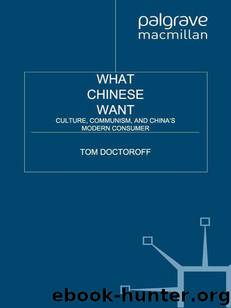What Chinese Want: Culture, Communism and China's Modern Consumer by Doctoroff Tom

Author:Doctoroff, Tom [Doctoroff, Tom]
Language: eng
Format: mobi, epub
Publisher: Macmillan
Published: 2012-05-21T16:00:00+00:00
Image 20.2 In China, even childhood is a rat race. The competition for academic achievement is intense. Hobbies, particularly playing instruments, have little to do with self-fulfillment. They are means of cultivating the discipline required to excel in school and, later in life, on the business battlefield. (Courtesy ImagineChina)
What’s the natural result of a monomaniacal focus on academic achievement? Stress and guilt. According to a study conducted by the China Teen Research Center, 75 percent of children aged thirteen to fifteen spend more than eight hours studying every weekend; 65 percent feel stressed or very stressed about academic performance; and 66 percent take courses during summer and winter holidays. Parents are equally anxious. Research piloted by the China Institute of Education and Learning found that 50 percent of mothers “care about nothing other than their child’s studies,” but 83 percent “worry about reducing the burden of heavy daily workloads.” One mother expressed ambivalence: “I know he is unhappy. I know he should enjoy life. But this is China. What can I do?”
The tension between parents’ determination to prepare children for the rat race and their more humane impulse to cut slack is palpable. Their angst is underscored by the growing realization that China’s memorization-driven pedagogy is ill suited for emerging economic sectors, particularly services and positions requiring leadership or creativity.
BRANDS TO THE RESCUE: HAPPY ACHIEVEMENT
The ambivalence of parents is fundamental; hence the profusion of brands that aim to reconcile achievement with delight. Five key themes have emerged:
Eliminating the struggle between “good for you” and enjoyment. Chinese mothers are drawn to brands promising “stealthy learning”—that is, intellectual development masked as fun. Disney will succeed both as an educational franchise—its English learning centers are going like gangbusters—and theme park. McDonald’s restaurants, temples of childhood delight in the West, have morphed into scholastic playgrounds in China: Happy Meals include collectible Snoopy figurines wearing costumes from around the world, while the McDonald’s website, hosted by Professor Ronald, offers Happy Courses for multiplication and “chengyu fun” (that is, classical four-character Chinese phrases, the usage of which is a sign of a keen mind). Smarties’s “colorful creativity” platform encourages kids to “sweeten imagination” by arranging candy pellets into art pieces. Skippy peanut butter combines “delicious peanut taste” and “intelligent sandwich preparation.”
Transforming protection-based safety into joy. Parents stop at nothing to protect investment in their child. That is why some of China’s most powerful brands have safety propositions. Procter & Gamble’s Safeguard soap, for example, has maintained a 25 percent market share for more than twenty years by focusing on “germ kill.” China Mobile offers “safety check” and “school time management”—short-message services for parents who demand “anytime, anywhere” communications with teachers. China’s millennial generation is swaddled. In the words of an eight-year-old, “I have a wonderful time when I’m on my own but my mother worries. Sometimes I feel like I’m in jail.” In the past few years, progressive brands have begun to address the tension between safety-driven regimentation and discovery. Safeguard has elevated its aforementioned germ-killing functionality into a richer “freedom to learn” angle.
Download
What Chinese Want: Culture, Communism and China's Modern Consumer by Doctoroff Tom.epub
This site does not store any files on its server. We only index and link to content provided by other sites. Please contact the content providers to delete copyright contents if any and email us, we'll remove relevant links or contents immediately.
Influence: The Psychology of Persuasion by Robert B. Cialdini(4673)
The Miracle Morning by Hal Elrod(4518)
The Hacking of the American Mind by Robert H. Lustig(4277)
Pre-Suasion: A Revolutionary Way to Influence and Persuade by Robert Cialdini(4112)
Unlabel: Selling You Without Selling Out by Marc Ecko(3569)
Ogilvy on Advertising by David Ogilvy(3470)
Hidden Persuasion: 33 psychological influence techniques in advertising by Marc Andrews & Matthijs van Leeuwen & Rick van Baaren(3427)
Purple Cow by Seth Godin(3118)
Who Can You Trust? by Rachel Botsman(3070)
Kick Ass in College: Highest Rated "How to Study in College" Book | 77 Ninja Study Skills Tips and Career Strategies | Motivational for College Students: A Guerrilla Guide to College Success by Fox Gunnar(3056)
This Is Marketing by Seth Godin(2951)
The Marketing Plan Handbook: Develop Big-Picture Marketing Plans for Pennies on the Dollar by Robert W. Bly(2917)
I Live in the Future & Here's How It Works by Nick Bilton(2913)
The Power of Broke by Daymond John(2848)
Building a StoryBrand by Donald Miller(2820)
The 46 Rules of Genius: An Innovator's Guide to Creativity (Voices That Matter) by Marty Neumeier(2742)
Draw to Win: A Crash Course on How to Lead, Sell, and Innovate With Your Visual Mind by Dan Roam(2713)
The Tipping Point by Malcolm Gladwell(2641)
Market Wizards by Jack D. Schwager(2604)
